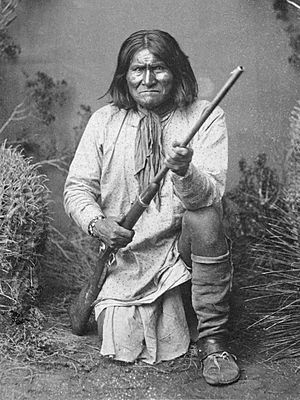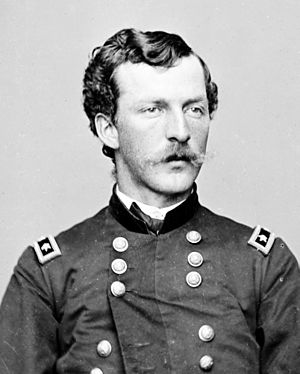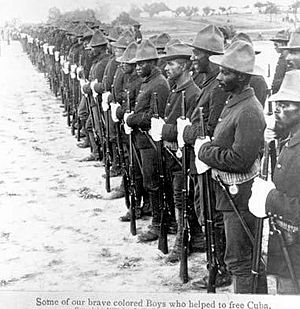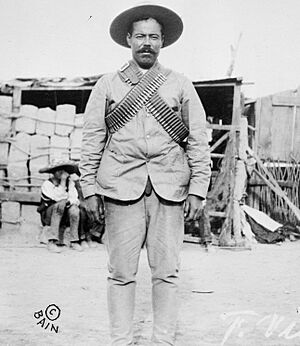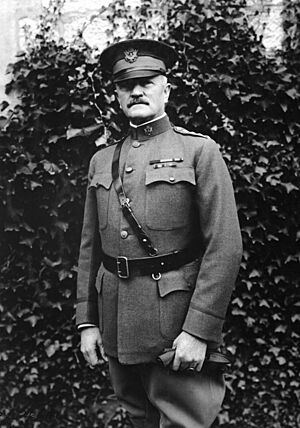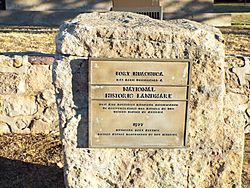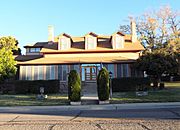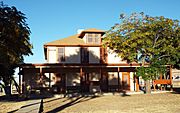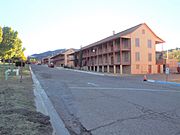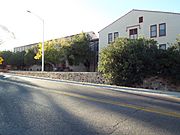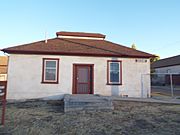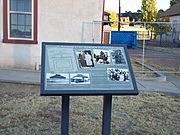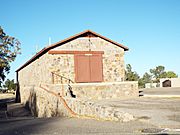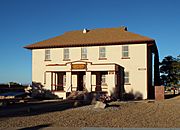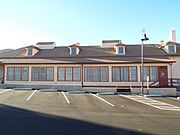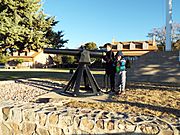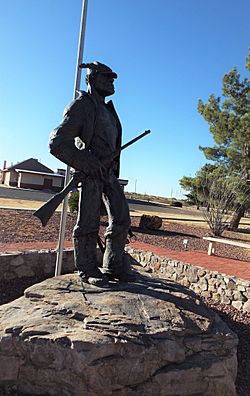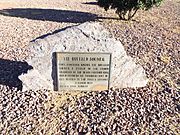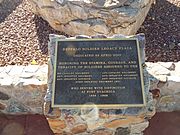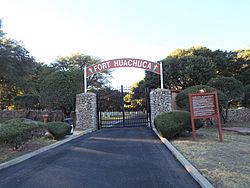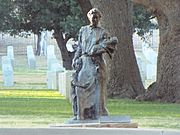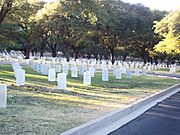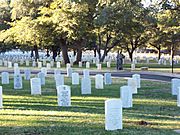Historic properties in Fort Huachuca National Historic District facts for kids
Quick facts for kids Fort Huachuca National Historic District |
|
|---|---|
| Sierra Vista, Arizona | |
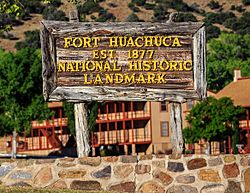
Landmark sign on the Brown Parade Field in the historic district of Fort Huachuca
|
|
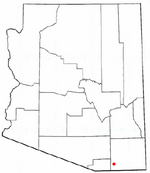
Location of Fort Huachuca, Arizona.
|
|
| Coordinates | 31°33′19″N 110°20′59″W / 31.555357°N 110.349754°W |
| Type | Army Post |
The Fort Huachuca National Historic District is a special place in Sierra Vista, Arizona. It's also called Old Fort Huachuca. This area is part of an active United States Army base. The fort is located at the bottom of the Huachuca Mountains. It's about four miles west of Sierra Vista, on AZ 90 in Cochise County, Arizona.
Fort Huachuca has a long and interesting history. It was once the main base for General Nelson A. Miles during the Apache Wars. This was until Geronimo, a famous Apache leader, surrendered in 1886. Later, in 1913, the fort became home to the 10th Cavalry Regiment. This group was known as the "Buffalo Soldiers" and was made up of African American soldiers. General John Pershing also used the fort from 1916 to 1917. It was a key place for supplies during his mission against Pancho Villa. Colonel Charles Young, the first African American to become a colonel, even commanded the fort. Because of its important past, Fort Huachuca was named a National Historic Landmark in 1977.
Contents
Early History of Fort Huachuca
Ancient People and Explorers
Long, long ago, about 13,000 years ago, the Clovis people lived in this area. They were hunters who chased large animals like mammoths. Archaeologists believe that different Native American tribes lived here since about 600 CE. These tribes included the Hohokam, Mogollon, and Trincheras people. You can even find Apache drawings from the 1700s in the area.
In 1540, a Spanish explorer named Francisco Vázquez de Coronado came through this region. He was looking for a legendary place called the "Seven Cities of Cibola." People believed these cities were made of gold! Coronado and his men were the first Europeans to explore this part of Arizona. But, the golden cities were just a myth.
Later, in 1699, Father Kino visited the area. He was a Jesuit missionary, explorer, and mapmaker. Father Kino helped set up many missions across the Southwest.
Becoming Part of the United States
In 1821, the area became part of Mexico. This happened when Mexico won its independence from Spain. But in 1854, it became a United States Territory. It was called the New Mexico Territory then. Finally, in 1863, Arizona became its own official U.S. territory. This was thanks to something called the Gadsden Purchase.
Camp Huachuca and the Apache Wars
After gold was found in California, many people from the eastern United States moved west. Some of these pioneers settled in Arizona. They created travel routes near where Fort Huachuca is today. These early settlers often faced attacks from the Chiricahua Apaches. The Apaches would then escape into Mexico using routes through the San Pedro and Santa Cruz valleys.
Geronimo was a brave Chiricahua Apache leader during the Apache Wars. When he was 28, a terrible event happened. While he and other Apache warriors were away, many women and children in their camp were killed. This included Geronimo's mother, wife, and three of his children. This sad event led him to fight against those who tried to control Apache lands.
In February 1877, Colonel August V. Kautz ordered a camp to be built in the Huachuca Mountains. The Native Americans called these mountains "place of thunder." This camp was first named Camp Huachuca. In 1882, it officially became a fort and was renamed Fort Huachuca.
In 1886, General Nelson A. Miles made Fort Huachuca his main base. It was a key spot for supplies during the campaign against Geronimo. Miles took over from General George Crook in fighting Geronimo. Miles's troops traveled thousands of miles tracking Geronimo. Eventually, First Lieutenant Charles B. Gatewood was able to talk with Geronimo. Geronimo and his followers agreed to go to a reservation in Florida for two years. However, they were not allowed to return to their homeland, which was a broken promise.
The Buffalo Soldiers
Even after Geronimo surrendered, there were still problems. There were other Native American groups, Mexican bandits, and American outlaws. In 1913, Fort Huachuca became the home base for the 10th Cavalry Regiment. These soldiers were known as the "Buffalo Soldiers." They were African American soldiers. The 10th Cavalry continued to fight the Apaches even after Geronimo's surrender. One of their last battles was near the Salt River in Arizona in 1890. Sergeant William McBryar earned the Medal of Honor for his bravery in that fight.
General John Pershing used Fort Huachuca as a supply base from 1916 to 1917. This was during his mission into Mexico against Pancho Villa and his men. Pershing sent the 10th Cavalry to chase Villa. Major Charles Young, an African American officer, led a group of the 10th Cavalry during this mission. They faced people in Mexico who supported Villa. The Mexican authorities did not want Villa captured by Americans. This led to misleading information, and Pershing's mission did not succeed in catching Villa.
When Lieutenant Colonel Young returned from Mexico, he started a school at Fort Huachuca. This school was for African American enlisted men. He believed that future wars were coming. He wanted men of his race to be ready for officer training. Young was the first African American to be promoted to colonel. In September 1916, he became the commander of Fort Huachuca.
The Old Post Cemetery
The historic Old Post Cemetery was first set up in 1877. It was moved to its current spot in 1883. Many soldiers who died during the Apache Wars are buried here. This includes Apache Scouts and their families. More than 4,124 U.S. Military Personnel are buried in the cemetery. Among them is Apache Scout Shorten Bread, who helped track Geronimo. Miss Carrie A. Clark, who was the postmistress, is also buried there.
Colonel Louis A. Carter is also buried in the cemetery. He was an African American chaplain who served with all four black regiments of the Regular Army. He was the second African American Army chaplain to become a colonel. He served at Fort Huachuca from 1913 to 1915 and again from 1935 to 1940. There are also some unmarked graves outside the cemetery wall. A bronze statue called "Mourning Hearts, A Soldier's Family" is in the cemetery. It shows a woman and children mourning a soldier. This statue was given by the Huachuca Museum Society in 1996. The cemetery is 7.3 acres large.
Fort Huachuca Today
The historic district is still part of Fort Huachuca, which is an active United States Army base. It is managed by the United States Army Installation Management Command. It was named a National Historic Landmark in 1977, recognizing its important place in American history.
Historic Buildings and Places
Here are some of the important historic buildings and places at Fort Huachuca:
- Pershing House – Built in 1884. General John J. Pershing stayed here in 1922.
- Original Fort Headquarters – Built in 1880. This building is now the Fort Huachuca Museum. The museum opened in 1960. It collects and shows items from the fort's history and the military in the Southwest.
- Old Post Barracks – Built in 1883. These were built as double barracks for soldiers. Today, these four buildings are used as offices. Each is named after a cavalry unit that was once at the fort.
- Leonard Wood Hall – Built in 1885. This large, two-story building was once the hospital. It is named after Major General Leonard Wood. He received the Medal of Honor and was Chief of Staff of the Army from 1910 to 1914.
- Ordnance Warehouse – Built in 1882. In the 1930s, this building was a shoe repair shop.
- Hangman's Warehouse – Built in 1880. This warehouse is known for some serious events that happened there in the 1940s.
- Rodney Hall – Built in 1917. This building is now the headquarters for Military Intelligence. Colonel George B. Rodney, who once commanded Fort Huachuca, was the first person to live here. He commanded the 10th Cavalry during World War I.
- Sam Kee Hall – Built in 1885. This hall is now used by a headquarters staff. It is named after Sam Kee, who opened a store at the post in 1881.
- Buffalo Soldier Legacy Plaza – This plaza was dedicated on April 23, 2009. It honors the Buffalo Soldiers.
- Parrott Rifle – This is an 1861 cannon, also called the “Parrott Gun.” It is in the Brown Parade Field and was used in the Apache Wars.
- Old Fort Cemetery – Established in 1877. The first person buried here was Private F.P. Kelly in 1877. Colonel Louis A. Carter, an African American chaplain, is also buried here.
- Mourning Hearts Statue – This statue was dedicated in 1996. It honors the wives who lost their husbands while they were serving in the military.
See also


